Initially Don didn’t want to go at all.
As usual when we’re planning a trip he checks the relevant government websites for warnings, most of which we ignore. The Canadian government website cautioned against going to the northeast and east coast of Borneo because of pirates from the Philippines. We could be kidnapped by pirates! That was a new one! So that was the end of that. We made plans to visit other parts of Borneo and Malaysia, and hoped to see orangutans at the rehabilitation centre near Kuching.
Oh I do love how the universe takes care of us. A good friend, quite by chance, was in Sepilok two weeks before we were due to be in Borneo and her reports were so tempting that all caution fell away. We were going to Sepilok, via Sandakan on the northeast coast of Borneo, to see the orangutans. Never mind that by the time we were in Kuching we’d started getting emails from friends saying that perhaps we should consider cutting our trip short and come home. The corona virus was getting to be big news, but it didn’t feel that threatening. We knew there were no cases on Borneo. And anyway, no matter what, we were going to Sepilok to see the orangutans!
Flying to Sandakan over the majestic Mount Kinabalu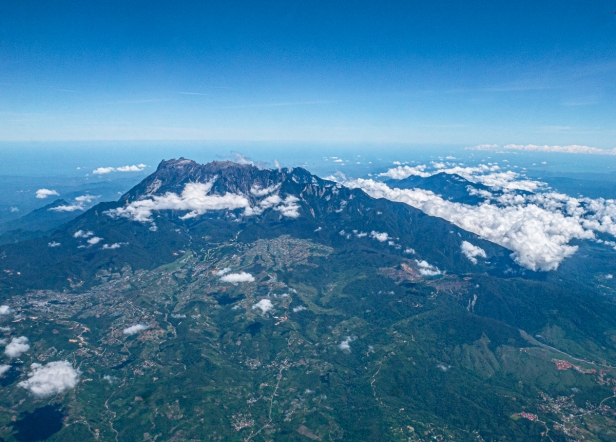
we’re excited by the idea that we might finally get to see these remarkable beings of the jungle, especially since we’d not been able to see any in Kuching.
Don fell in Bako, so our first stop in Sandakan is a medical clinic where he finally gets his wound dressed by a doctor, and then we take a Grab car (SE Asia’s Uber) to Sepilok. That’s another thing we have to thank our friend for – we’d never even heard of Grab until she told us about it. And she recommended a place to stay in Sepilok that turned out to be perfect.
We arrive at the Sepilok Jungle Resort to discover we have landed in paradise. The sprawling complex has comfortable rooms, a great restaurant, and a pool, but what really makes it is the lush tropical garden
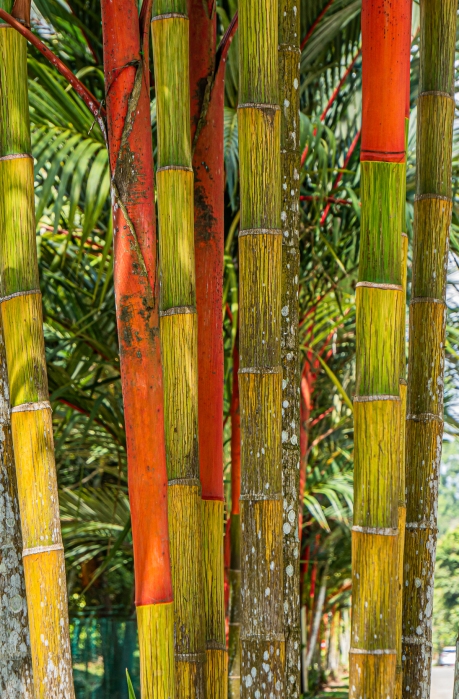
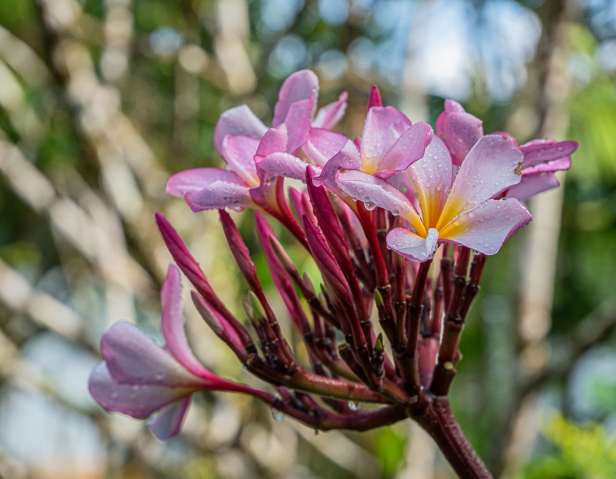

surrounding a small central lake.

We settle in and start exploring. Birds sing, the moist heat caresses me, the earth breathes a rich fertile fragrance, and tropical jungle beauty embraces me. I am so happy to be here. So happy. It is the kind of environment I love most, and it’s the last thing I expected.
I also never expected to see a Red Junglefowl on my first visit to the restaurant, and would have missed it had one of the servers not pointed it out to me. I thought he was just showing me a rooster, but no, this wild bird is native to SE Asia, and the primary ancestor of the domestic chicken. I guess chickens had to come from somewhere.
Looking out over the lake from the open-sided restaurant, we see a Stork-billed Kingfisher, all red, gold and blue splendour,

and on a local walk an Asian Water Monitor darts by and disappears into the undergrowth.
It being the tropics we see geckos everywhere. They are our beloved insect-eating friends,
but hopefully they’re not tempted to eat this beauty.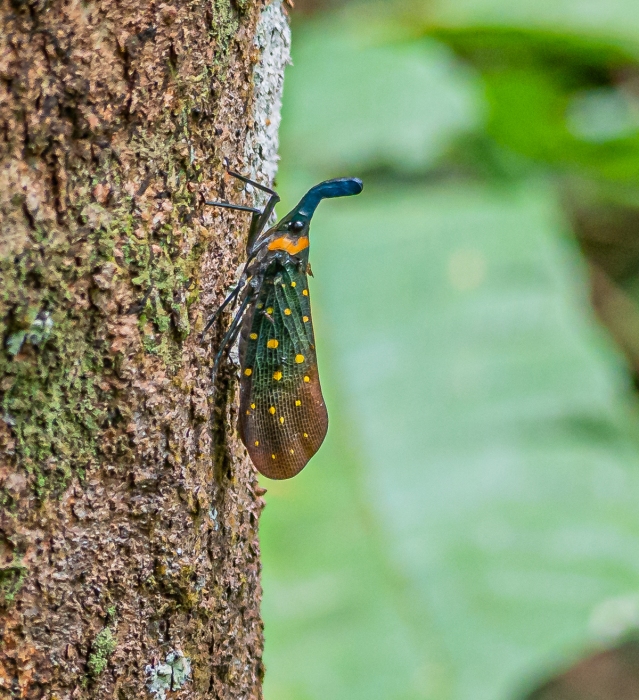
We settle in. We remember to breathe. We are filled with love and gratitude. Beauty and kindness surround us. We have three full days, and it’s so slow and serene sometimes it feels like three weeks. We wish it could be. Corona what?
Borneo, an island shared by Malaysia, Indonesia, and Brunei, is home to one the world’s only habitats for wild orangutans. The other is found on the neighbouring island of Sumatra. That’s it. Orangutans once ranged throughout SE Asia, but due to deforestation for palm oil plantations, and to a lesser extent hunting, they are now critically endangered. I’m just going to say right here that I hate the palm oil industry with a passion. It’s not just the orangutan habitat that’s been callously destroyed, but the habitat of all the other animals as well, not to mention the forest itself.
So as is always the case when a problem is recognised good people step in. One of a few rehabilitation centres in Malaysia and Indonesia, The Sepilok Orangutan Rehabilitation Centre, which adopts and nurtures injured, orphaned, or rescued animals in a protected environment, opened in 1964. In a process that can take years the young orangutans are trained to survive in the forest and eventually released. Since opening, Sepilok has successfully released over 100 orangutans to their natural habitat, although some continue to return for the twice-daily feedings. The food is deliberately bland to encourage them to forage for themselves in the forest, nevertheless each day there may be as many as five or six coming to the feeding platform for an easy meal.
Our first stop at the Centre is the nursery where we can watch the young from glass-panelled rooms overlooking their feeding and play area. (The following series of photos are a bit hazy since they were taken there.)
For two days we sit there for an hour or more morning and afternoon watching them, spellbound and smiling. They are so human! And indeed orangutans share 96.4% of their DNA with us, more than any of the other great apes. They are among the most intelligent of the primates, using a variety of quite sophisticated tools, and building elaborate nests high in the trees for sleeping each night. Their name comes from the Malay words orang, meaning man or person, and hutan, meaning forest – person of the forest.
I watch a mother slowly gently repetitively caress her new-born in a devoted meditation; I watch a couple of teenagers wrestling with each other, grabbing and biting and rolling around for a half hour or more in play that trains them for real life in the forest; and I watch these two kids, one playing with a stick, and the other determined to have it.

Some are content to just sit and eat,
some grab some food and swing away on the ropes,
and babies chase after their mamas, wanting some of whatever it is she has even if their mouths are already full.
From the nursery area we make our way on boardwalks through the jungle to the feeding platform. We arrive early and wait. The first sign is the shaking of leaves high in the forest canopy. Then we see the ropes starting to move, and then at last one comes into view.
And then more and more. Over the next hour or so we watch several orangutans come and go, grabbing food and swinging themselves up into the trees, or sitting on the platform feeding.
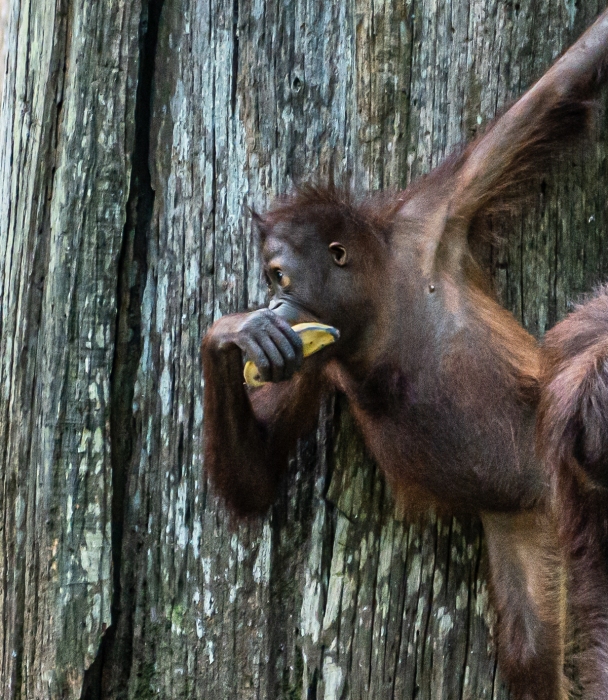

This one hangs by one hand with a banana in its other hand and each of its feet!
There are no table manners here. It’s boarding-house reach all the way. Get what you can and get it quick. This of course applies also to the squirrels that dive in at the end for leftovers,

and especially to the Pig-tailed Macaques.
When we arrived for the afternoon feeding we’re surprised, and a bit concerned to see the feeding platform entirely covered with the macaques, all waiting for food. Dozens of them.

And when the worker comes and climbs the ladder with a big bucket of food they all but attack him. He gets up there, throws the food at them and gets back down again in a hurry. They are very aggressive, so much so that even though the orangutans are bigger they will not go near them. We watch as one orangutan comes on a rope high above them. Gradually it moves lower and lower. No way it’s going to get on that platform with the macaques, especially not when there are big alpha males like this one,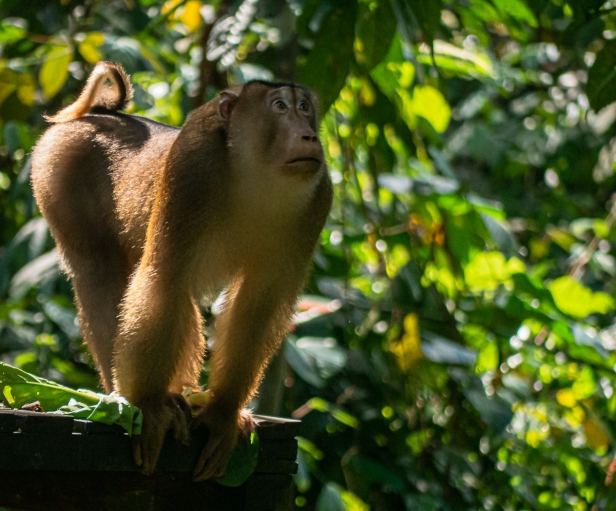
but it does finally get close enough to reach one of its very long arms down and grab a bite.
Having completely commandeered the space the macaques hang around
eating,
and playing until eventually they’ve had their fill and head off back into the jungle.
The highlight of the day comes as we’re walking back along the boardwalk to the entrance. Suddenly, coming towards us on her way to roost for the night are a mama and her baby. We freeze and watch her as she passes by, unconcerned by us and intent on her direction. It’s a magical moment.

A bit later we see one in the trees far from the feeding platform.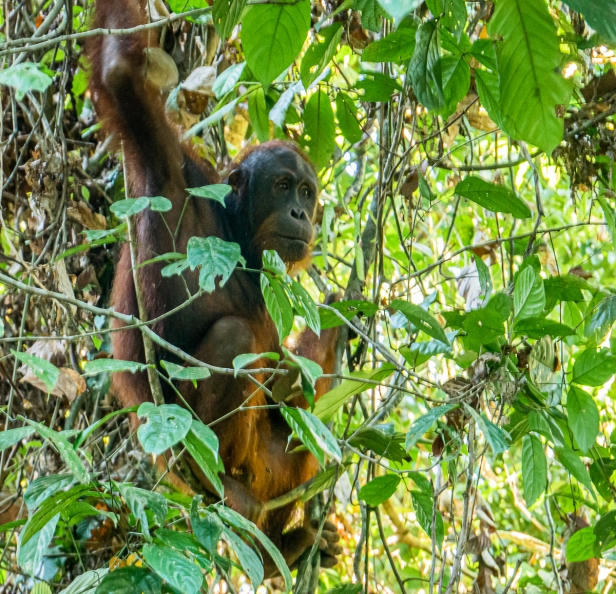
The next day, at both morning and afternoon feedings there are no macaques to be seen so the orangutans come to eat and play. This mama grabs a coconut and hangs around for a while husking it,
and then swings her way back into the jungle with the coconut still clutched in her feet.

Sepilok has more to offer than orangutans. Right next door is the Bornean Sun Bear Conservation Centre, providing care and rehabilitation for rescued sun bears. Founded in 2008 it’s the only sun bear conservation centre in the world.
The sun bear, found in the tropical forests of SE Asia, is the smallest, and most arboreal of the bears. Their name comes from their distinctive blond chest patch, which is unique to each animal like a fingerprint. We walk into the centre not knowing what to expect. We’ve heard of people who’ve not seen any bears there but the first thing we see is this: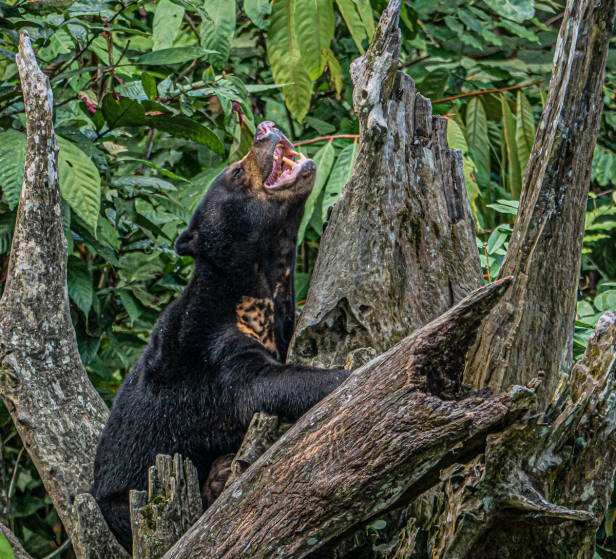
S/he is sunbathing.
Over the next hour we see several bears on the forest floor.


They are endangered due to deforestation (the palm oil industry again!), illegal hunting for bear parts, and wildlife trade. I could do a rant about all this, but would rather stay with how wonderful it was to see these happy rescued bears enjoying their day as much as we were enjoying ours.
In this video Michelle Yeoh narrates a documentary about the Sepilok Orangutan Rehabilitation Centre:
A short National Geographic video about orangutans:
A short National Geographic video about the Bornean Sun Bear Conservation Centre:
And a couple more photos, because orangutans.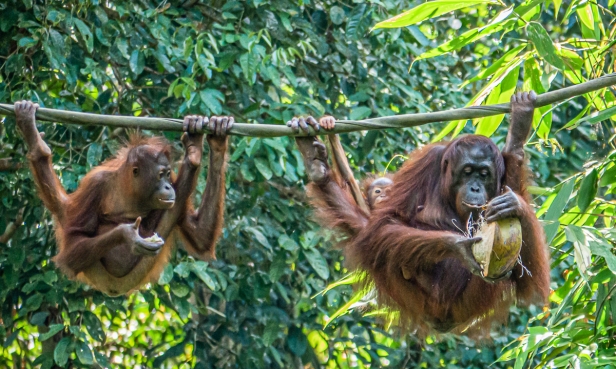

Next post: We had one more excursion from the idyllic Sepilok Jungle Resort – a day trip to the Kinabatangan River. Many macaques, proboscis monkeys, and best of all a Bornean pygmy elephant!
All words and images by Alison Louise Armstrong unless otherwise noted
© Alison Louise Armstrong and Adventures in Wonderland – a pilgrimage of the heart, 2010-2020.


Beautiful nature photos and poignant animal stories. Thanks for sharing.
LikeLiked by 2 people
Thank you so much. I’m glad you enjoyed it.
Alison
LikeLiked by 1 person
Wonderful, Alison. So glad you got to see this. And so glad you share your journeys. Hope you and Don are well. Love you, Kay
LikeLiked by 2 people
Thanks Kay. We’re so glad we went there; it was a really special time. We are both well. Hope you are too.
Love to you too.
Ali xo
LikeLike
Beautiful! I am going to show this post to my Uncle. He was waiting for this post more than anyone. And waiting for the next post. God bless you both. take care.
Loving
Jeena. 🙂
LikeLiked by 3 people
Thanks so much Jeena. I hope your uncle enjoys it. Blessings to you too.
Alison
LikeLiked by 1 person
Yeah absolutely! He enjoyed. ❤ 🙂
LikeLiked by 1 person
What a wonderful experience for both of you. The pictures are amazing as always. I especially love the picture of the mom and baby. You can live off these memories until we can all travel again. Stay safe.
LikeLiked by 2 people
Thanks so much Darlene. It was a really special time and I’m so glad we went. That mom and baby moment was so precious.
Yes, living off these moments. Trying to come to terms with the idea that we might never be able to travel again 😦 but it’s okay as long as I stay present. Present is pretty darn good 🙂
Stay safe.
Alison
LikeLiked by 1 person
Present is pretty good, thanks for reminding me. xo
LikeLiked by 1 person
Amazing experience
LikeLiked by 2 people
Yes, it really was. So special.
Alison
LikeLiked by 1 person
Okay, Alison and Don, I for one am glad you ignored threats from coronavirus at home at pirates at large and made the trek. What a delightful photo essay. And the shots of the orangutangs feeding with two feet and hand randomly holding on, priceless. As was the one go mother and baby! Thanks. –Curt
LikeLiked by 2 people
Thank you much Curt. I’m glad you enjoyed it. We are also glad we ignored all the threats! What a special time we would have missed out on.
That mother and baby moment really made the day. It was a pretty fabulous day but that moment was pure gold.
Alison
LikeLike
Absolutely! To be treasured. –Curt
LikeLiked by 1 person
I love your photos so much! Your trip looks like so much fun! Thank you for mentioning the palm oil industry too.
LikeLiked by 2 people
Thank you so much. It was a really special trip, and yes, lots of fun.
I hope somehow there will be an end one day to the palm oil industry. It’s so destructive.
Alison
LikeLiked by 1 person
I hear you! I do my best not to use palm oil products but there’s been some times I have been in a pinch
LikeLiked by 2 people
Just recently my usual brand of almond butter was not available so I grabbed another brand. When I got home I was disgusted to see it had palm oil added! I’ll be sure never to get it again!
A.
LikeLike
It’s hard when you’re in a pinch like that to not feel guilty. Now that I’m not a student anymore, I can be more particular about what I buy. I also have a similar attitude to Amazon as the palm olive industry. I don’t use it unless I have no other choice. Ijust see these beautiful photos you have and I think how can people be so cruel to destroy this for profit?!
LikeLiked by 2 people
Yes I know. It’s heart breaking, but I’m still optimistic. I’m not sure why, but then I remember there are good people everywhere. Things will change.
A.
LikeLiked by 1 person
I’m rather optimistic too. I think there will be a cultural shift
LikeLiked by 1 person
What a wonderful place! Thanks for the post.
LikeLiked by 2 people
My pleasure Shanda. Yes, a very wonderful place!
Alison
LikeLike
Love the photos. Such a wonderful experience.
LikeLiked by 2 people
Thanks so much Peggy. Highlight experience I think. Looking back I think Sepilok will join the dozen or so highlight experiences of our travels.
Alison
LikeLiked by 1 person
That’s some recommendation. Adding to my list for someday.
LikeLiked by 1 person
An animal character in a book series I read years ago was a sun bear. I thought it was a made-up thing! I can see now why the author chose to reference them.
Although they are incredible, those orangutan pictures are just stunning. I especially love the shot of the squirrel with the watermelon!
LikeLiked by 2 people
Thanks so much Felicity. The orangutangs were so much fun to photograph. They play as freely as children, and they’re so agile and flexible. And the squirrels were pretty cute. I’m glad I got the shot of the little watermelon thief!
Alison
LikeLike
Wonderful.. beautifully written too. Enjoyed every bit of it..
LikeLiked by 2 people
Thank you so much! I’m glad you enjoyed it. It was such a special experience.
Alison
LikeLike
If I had a bucket list, this place would go straight to my number one. Gorgeous. It even looked fantastic before you got to the orangutangs! I especially love the picture of the first one – a great way to start off my Sunday – with a smile. Completely magical, apart from those menacing macaques and the dastardly palm oil.
LikeLiked by 2 people
Thanks Tracey. I’m glad you enjoyed it. Highly recommend Sepilok. Also recommend Sepilok Jungle Resort. The whole time there was just really magical.
Alison
LikeLike
Alison – What good fortune this visit was, and you are so nice to share it with the world. All of this armchair travel is helping me adjust to the fact that I won’t be actually traveling around much for quite a while. Just think how much re-reading I can do in my favorite blogs – look for me diving into your reserves some time soon! – Susan
LikeLiked by 2 people
Thanks so much Susan, and my pleasure. I love the process of putting a blog post together – going through the photos, and my notes, and doing some research. I remember far more about our travels than Don does because of doing the blog. I kind of get to go everywhere twice.
Yeah, no travelling for a while 😦 but armchair travel is good. Happy diving. Hope you find some stuff you like – here and elsewhere.
Alison
LikeLiked by 1 person
What a treat!
LikeLiked by 2 people
Oh it really was! We’re so glad we went.
Alison
LikeLiked by 1 person
Love your photos! You have such a gift for capturing wildlife. Sounds like a magical stay, too. Great that you threw caution to the wind and went anyway, and were so richly rewarded with this experience. Hope you’re having a nice weekend!
LikeLiked by 2 people
Thanks Kelly. We’re so glad we went. It was a good decision even though on the outside it looked a bit risky. We were so calm and clear about it.
I would not have made a good photographer in the pre-digital age lol. Lots of garbage in between a few good ones. But the orangutang were so active and comical it would have been hard not to get a few good shots. Truly magical! And that sun bear! Right there sunbathing when we walked in and not even moving for several minutes!
Had a lovely weekend thanks – picnic dinner down by the river. Hope you guys did too.
Alison
LikeLiked by 1 person
I loved this post immensely, Alison. What a marvelous experience! Your photographs are fantastic along with your writing. Thanks so much. 🤗
LikeLiked by 2 people
Thank you so much Jane. Yes, a truly marvellous experience. Sooo glad we went. We didn’t know what to expect really but the 3 days there turned out to be just magical.
Alison
LikeLiked by 1 person
How great that you guys snuck this in before travel came to a halt. You’re not kidding when you say you landed in paradise. The vegetation is amazing. Is that bamboo? I’ve never seen the orange colour. I could look at your orangutang photos all day…their expressions, their dexterity, the mother/child bond…beautiful! When we were in Luang Prabang we saw bears at a sanctuary that looked like this, but I don’t remember that unique blond patch…must have been a different species.
LikeLiked by 2 people
It was such a good decision to go to Sepilok! It was one of the highlights of that entire trip. I’d not seen bamboo like that before either. We walked down a whole street of it. When I did a bit of research to find out what kind it is I discovered that bamboo comes in all kinds of colours and all the research led to places to buy seeds/plants. But I think these are domestic breeds, and I’ve a feeling the ones on Sepilok are native. Anyway I was so taken by its beauty.
And of course the orangutangs were really special. We watched them for a couple of hours twice a day for 2 days – always so entertaining.
I had a quick look at the LP bear rescue website and it seems from the pics they have several species there.
A sunny day! At last! Tomorrow too.
Alison
LikeLiked by 1 person
Enjoy the sun while it lasts! Fingers crossed for Canada Day.
LikeLiked by 1 person
I love orangutan, although I have yet to see one in the wild. I’ve been thinking of going to an orangutan conservation center on the Indonesian part of Borneo, although with Covid-19 restrictions I’m avoiding traveling by plane at the moment — well, I haven’t really traveled anywhere since December last year. But the fact that this orangutan sanctuary is located right next door to a Bornean sun bear conservation center really makes me think whether I should come to Sabah instead. Tough call. By the way, have you seen how the macaques behave in Lopburi, Thailand during the lockdown? Tourists usually fed them, but since there were hardly any visitors during this period, the monkey became really aggressive. This is why I’m so against feeding wild macaques — I have seen in some places in Indonesia how much of a headache they can become.
LikeLiked by 2 people
I’d recommend Sepilok for sure. It was a winner for us in every way.
I have heard about the macaques in Thailand, and in India too! They really should not be encouraged in any way, especially in the towns. I suspect the staff at Sepilok later chased that troup back into the jungle so the orangs could have the feeding area again.
I see you drop the ‘g’ on the end. I looked up what to call them and every where gave four acceptable names – with or without the ‘g’ on the end, and also hyphenated, and also written as 2 words. I guess it depends on where you’re from. I know that in Malay it doesn’t have the ‘g’ but I decided to stick with what I was familiar with since it was included as an acceptable term.
Alison
LikeLiked by 1 person
I call them orangutan because, like you mentioned in this post, the name comes from orang and hutan. The thing is, in Indonesian (and Malay), utang or hutang means debt. So to me orangutang sounds like someone who has a debt. 🙂
LikeLiked by 1 person
Oh funny! So orangutan must make much more sense to you.
A.
LikeLike
Your pictures are absolutely wonderful, I felt I was there with the animals. You must be so chuffed that everything worked out for you and you got this one last very precious trip before travel came to a grinding halt.
LikeLiked by 2 people
Thank you so much Phoebe. We were definitely chuffed! We felt really lucky to get this wonderful experience, and then suddenly the world closed down (including Malaysia) and we had to hightail it home.
Alison
LikeLike
There were moments where I was right there with you in the jungle – thank you, you transported me away from the humdrum of daily life in these strange times to a new world.
LikeLiked by 3 people
Thank you so much Jen. That’s the best compliment!
Yes, indeed, strange times. I’m heartened by the news that some of Europe is opening up, including to Canadians so maybe we’ll be able to travel again later this year.
Alison
LikeLike
Aaw lovely. We stayed at the same resort in Sepilok it was so beautiful. Did you do the free evening jungle walks? I loved the food there too. We did the orangutan, sunbear and RDC in Sepilok😊 x
LikeLiked by 2 people
Thanks so much Dannii. I’d recommend this resort to anyone. We loved it, and I agree the food was fabulous. We didn’t even know about the evening jungle walks! Wish we had. We also went to RDC and a couple of the jungle pics above are actually from there. Beautiful place but not as interesting as sun bears and orangutangs!
Alison
LikeLiked by 1 person
Thank you for sharing your experience and these beautiful photos of these magnificent creatures. I love all the photos, they so capture the personalities and characters and human like qualities that orangutangs have.
I remember flying into Malaysia and noticing the miles and miles of palm trees that were planted to replace the indigenous forests that had been there before and housed orangutangs and other wildlife. One of the tragedies of our times is that almost every single species of wildlife is now threatened and or on the endangered list. I hate the palm oil industry, like you, with a passion. So many products, both foods and cosmetics now contain palm oil. I always read labels carefully so as to avoid supporting this abhorrent industry.
Beautiful post. Mesmerizing photos. I can always spend hours watching wildlife. There really is nothing that beats that in my mind.
Peta
LikeLiked by 3 people
Thanks so much Peta. My pleasure. It was amazing to watch them. Their personalities were evident, and their wonderful playfulness.
I also could spend hours watching wildlife and consider it a huge privilege whenever I get the chance. I’m just remembering a 10-day Vipassana retreat we did last summer. We could walk on forest trails during breaks and one day I was alone at the far edge of the property and suddenly I noticed a deer in the forest, quite close to me and it didn’t get scared and run away but stood and looked at me, as if it was saying hello. We simply observed each other for about a minute or more in the most sacred way. I felt so gifted. It was really magical.
Ha! I bought a different brand of almond butter because there was none of my usual brand, and didn’t think to look at the label until after I got home. Appalled to see it contained palm oil. Why?!! Anyway I learned my lesson that’s for sure. When we went on the Kinabatangan River trip it was about a 3 hour drive I think to get there and there were palm plantations the whole way as far as the eye could see – just devastating 😦
I’m glad you enjoyed the post. It was such a special experience, and I’m so happy to be able to share it.
Alison
LikeLiked by 1 person
and know I read more about coconut oil as well… all so much … 😞
LikeLiked by 2 people
😦 😦 😦
LikeLike
Erik Meijaard wrote something in a piece i don’t know where but it’s out there…so many ways need to change…
LikeLiked by 1 person
Warnings about pirates play into most of our travel plans :-). Luckily, we managed to steer clear of them all the way around.
I love your story of the universe taking care of you, a welcome reminder as I navigate through a challenging time. I am glad that Don’s fall was not too severe, and you were able to address quickly.
The view of Borneo from on high is magnificent. I only managed a view of the island (from the Indonesian side) at sea level. And I admire you kingfisher pictures with great envy as I never managed to take any as beautiful. I also never managed to see an insect as glorious as the one that may have been dinner for the Gecko.
I share your dislike for the palm oil industry, or at least those that have (continue to) cleared Orangutan habitats. We were as spellbound by the gentle giants when we visited with them in Kalimantan. Your images bring back such great memories of that time. You capture their essence soulfully.
Never met a sun bear on our travels, so I am in awe of the ones showcased here.
Adore your photography and pinned this post o three different boards.
LikeLiked by 2 people
Thank you so much Lisa. Of course you get warnings about pirates! I didn’t even think of that but it makes perfect sense. They’ve been romanticized in literature and modern movies (Jack Sparrow anyone?) but I don’t imagine they’d be so damn romantic in real life.
I was so pleased with the shot from the plane window. I’ve not had much luck with plane window shots so this felt like a win. Also the kingfisher! It just sat there posing for me with the perfect background. And that insect is a beauty isn’t it?! So many of the tropical ones are.
Palm oil grrrrr. At least there are some sanctuaries that are working to save these beautiful animals. If you watch the Michelle Yeoh video (47 mins) you’ll see that they’re working on establishing a long corridor of natural habitat for the orangs. And also in places planting native trees to re-establish natural forest growth again. So hopefully all is not lost . . .
Thank you so much for the pins! I really appreciate that.
Hope you’re both safe and well and that the Captain continues to improve!
Alison xo
LikeLiked by 2 people
Anyone having a ‘low’ day would instantly feel better – strictly by scrolling through the images! Wow, my heart leaned forward in hopes of bridging the distance between those lovely creatures and me.. The icing on the cake would be to find you both still there – in loving harmony with the people of the forest, the orangutangs and other wildlife!
LikeLiked by 2 people
Thanks so much Lisa. How lovely to imagine you leaning in to better feel the orangs. They are such wonderful animals. Watching them was pure joy.
I do kinda wish we were still there. It was such a special place, and I love being in the tropics, but at this time it’s better that we are safe home in Canada.
Hope you too are safe and well.
Alison
LikeLike
I could really feel the magic of your experience in your text and your incredible, sharp photos. What an amazing creatures the orantutangs are, they sure give ‘hanging out’ another meaning. And so nearly related to us. It is unbearable to think of them disappearing; as if part of the family is being wiped off the earth. Thanks too for the videos!
LikeLiked by 2 people
Thanks so much Astrid. The whole time there was really really special. We’d landed in paradise and had orangutangs on top of that! Magic indeed! It was so amazing to see them, especially when we saw them in the forest away from the feeding areas.
They’re still endangered but there are some really good efforts going on that I’m still hopeful. The rehabilitation centres and the reforestation combined will hopefully be enough to save them.
Alison xo
LikeLike
Alison, this is like a Nat Geo exclusive – our own private tour! What an experience. It’s long been on our bucket list, so congrats to you for braving the pirates and coronavirus to bring this to us. As always, your photos are fabulous – I’m still smiling over the mama with the baby … and coconut. A true multitasker. 🙂 ~Terri
LikeLiked by 2 people
Wow, thanks so much Terri. It was a truly amazing experience! (Though not private – there were plenty of other people there too, but visitors are well shepherded through the complex so they can see the animals without disturbing them, and it was never crowded).
Pirates ha! Corona ha! Nothing stands between us and orangoutangs! LOL. We were actually very calm. It just felt right to go there, and I’m so glad we did. You know what it’s like to follow your intuition when travelling. It always has the best results.
I do hope you get there one day. It’s really special.
Alison
LikeLiked by 1 person
I don’t know if I’ll ever make it to see the orangutangs in person, but thanks to you, I almost feel like I have. A beautiful post – thank you for sharing the joy and wonder of these creatures. I’m glad you guys are safe and were enjoying the world as long as you still could. A good friend of mine was the California rep for moon bear rescue fundraising for a long time, and I’ve helped her over the years. So sad what they put the moon bears through. I can only imagine what the sun bears endure.
LikeLiked by 2 people
Thank you so much Peggy. I’m glad you enjoyed it. What an amazing experience it was to see them! The sun bears too have often been badly treated, probably much the same as the beautiful moon bears. It still breaks my heart how people can be so cruel to animals. There are moon bears at the rehab centre near Luang Prabang in Laos – is that the one you mean? At least there are organisations out there helping the bears. And the orangs.
Alison
LikeLike
I can only imagine how amazing it must have been! 🙂 The org my friend volunteers for is Animals Asia. If you don’t know them, maybe check them out. They do great work. The found is Jill Robinson. She is an incredible woman. I met her at one of my friend’s fundraisers in CA. I believe they have different facilities in different locations. When I was really involved with them they focused the majority of their work in China, negotiating for the release of the moon bears having the bile extracted from their stomach. It was unpredictable when they would get a release, and then they would immediately have to do a complex surgery on their stomachs where the extraction was taking place. Then they would move them to a sanctuary. I don’t remember where their sanctuary was based, but it would make sense that they would have several by now, as I believe they have grown a lot.
LikeLiked by 2 people
People are so cruel. And so wonderful! I remain hopeful that we’re at least balanced in numbers.
A
LikeLiked by 1 person
So so true. Optimism is the way to go, I suppose.
LikeLiked by 1 person
I didn’t realize that the feet of orangutans were shaped so much more like hands than what we typically think of as feet. Some of the pictures are disorienting, in a lovely way, to see more hands and grasping thumb than are expected. They’re amazing creatures and I loved your stories here. There is sadness, too, in knowing how constrained their range has become. And they do look so very human at times. So beautiful! Just being who they are…
Michael
LikeLiked by 2 people
Thanks so much Michael. They are indeed amazing creatures and I’m so glad I got to seem them up close and in a largely natural habitat. I too was a little disoriented by the all-hands-no-feet. It was wonderful to watch how incredibly agile they are because of it. Their movement is so fluid, and yes, beautiful, just being who they are.
There is some reforestation happening with the view to creating an unbroken corridor in Borneo so hopefully this will allow them to thrive.
Alison
LikeLike
Alison and Don: I don’t think you have seen these photos 🙂 – they are really beautiful! and your narration draws one in. All pics are beautiful, but the third and fourth ones are my favorite. Thanks for sharing.
LikeLiked by 2 people
Thank you so much for your kind words. I’m glad you enjoyed the post. It was such a special experience!
Alison
LikeLiked by 1 person
Hey I saw you content and it’s awsome
Would you like to join an international platform where you can show and spread your talent and message to a huge no of people if yes! Then click this link
https://wordallure.wordpress.com/2020/06/13/inviting-writers-worldwide/
LikeLiked by 2 people
Thanks so much Vikas. I’ll take a look.
Alison
LikeLike
You have outdone yourself! Your animal and nature photos are always magnificent, but these are truly outstanding. What I loved most was your ability to capture the orangutans’ contortions and expressions – incredible! I am also partial to the early photo of the vari-colored bamboo. So glad you pushed to get to this place!
LikeLiked by 2 people
Thank you so much Lexie! Such fulsome praise. Made my day! Thank you! We are very glad we pushed on to this place. It was definitely a highlight.
I too was taken with the vari-coloured bamboo – so beautiful. I’ve not seen it anywhere before so looked online to find out what I could about it and it turns out that one can buy bamboo and bamboo seeds in a huge variety of colours. What I saw in the garden at the resort and all along one of the roads there may or may not be native. (there’s a limit to my research skills and patience 🙂 )
Alison
LikeLiked by 1 person
Beautiful experience and photos 💜
LikeLiked by 2 people
Thank you so much Rojeena. It was a really special time.
Alison
LikeLike
It’s true the smiles seeing the critters in the wild…I could watch for a long while as well … it’s always nice to re/visit your posts … sharing this one with the starseed ☺️🤓💫 smiles have a happy day Alison
LikeLiked by 2 people
Thanks Hedy. I too could watch for a long time – pretty much any kind of wildlife, being wild, doing its thing. Endless smiles. Thanks for sharing 🙂
Alison
LikeLiked by 1 person
The energy of them would have been amazing…one day yet 🤓☺️🤗 hugs many
LikeLiked by 1 person
Yes, it really was. Hugs back.
LikeLiked by 1 person
It’s just all beyond belief, Alison. You must be so glad that you made the decision to go to Borneo. In addition to the orangutans, I love the abstract/real quality of the bamboo (fourth photo). And the Junglfowl! 🙂 The Kingfisher has the same look that they all do, a look I love for its intense silliness. That snouty, yellow-polka-dotted insect sure was a find! Surely your time in Borneo was well-spent, meditating on what it is to be a primate – or a human – and worth having to quarantine for a few weeks.
LikeLiked by 2 people
Thank you so much Lynn. It was all a bit beyond belief, a bit surreal the way it all unfolded. When we were in Kuching (just prior to Sepilok) we got emails from friends saying to come home and it was so very clear that first we were going to Sepilok. We were so at peace with it all. When it came right down to the wire there was no question that this was our next step no matter what else was happening in the world. And what a huge blessing it was.
That bamboo! I’d never seen anything like it, and there was a whole street lined with it. So I looked online and apparently you can buy bamboo in a wide range of colours, though I like to think this particular variety is native to Borneo, but I really don’t know that. *Love* the colours!
Oh the junglefowl is a minor triumph for me. I looked below from the deck into the scrubby undergrowth, it was so dark down there, and made sure I had enough shutter speed and just clicked. It was such a poor photo that I wasn’t going to use it at all. I even wondered why I took it because I thought he was just showing me a common rooster. Then I started to see what I could bring out in Lightroom. It was a revelation. And then I discovered that it is in fact a native bird.
I loved how the kingfisher posed for me 🙂
All in all it was one of the best decisions we’ve made – follow intuition and the universe takes care of you. Definitely worth having to quarantine.
Alison
LikeLiked by 2 people
I like how enthusiastic you became about that bamboo…whatever the facts, for you that one is Borneo bamboo. Great story about the Junglefowl! ANd I’m not surprised that the Kingfisher posed – they seem to naturally take a proud, intense stance. I’m glad you went with your intuition. 🙂
LikeLiked by 2 people
Me too! 🙂
LikeLiked by 1 person
Everything about this is just so magical! From where you stayed (my jaw dropped when I saw the lake), to the abundant wildlife, to the conservation centers! I admit I know very little about Malaysia in general and nothing about Borneo, but now it seems I must find out!
LikeLiked by 2 people
It was an absolutely incredible experience! I’m so glad we went there instead of running home to Canada. We also had some time in Kuching, and went to Bako National Park (see previous post on Malaysia). I highly recommend it. We had no idea what to expect really but absolutely loved our time in Malaysia and wish we could have stayed longer. And the food is to die for.
Alison
LikeLike
What an absolutely amazing experience Alison! I love all of the pictures. So much wildlife. I would have been in heaven too and breathing purely. I remember when you were there and trying to get back. So nice to have this incredible experience before we had to all stay at home for a bit. Another place to add to my long list of places I want to go! 🙂
LikeLiked by 2 people
Thanks so much Nicole. It really was an amazing experience. Definitely one of the highlights of our travels. It was definitely the right decision to stay for Sepilok and then come home. No travel for a while now 😦
I hope you get there one day. We loved Malaysia – well Borneo, which is the only part we saw.
Alison
LikeLike
This is a post dear to my heart. I feel as though I recognize some of the orangutans… I adore Borneo, having been twice. Sepilok is a magical place, thank goodness it exists for the orangutans.
LikeLiked by 2 people
I do think it’s possible you could recognize some of the orangs. I think we saw the same ones a couple of times so perhaps there are those that come regularly to feed. We too adored Borneo, and would love to go back. And yes, thank goodness for Sepilok.
Alison
LikeLike
This looks like an amazing trip, Alison! Borneo has been on my list for so long and seeing your photos just made me wish I could transport myself there with no thoughts to what’s taken place over the last 12 months. I could so relate, too. I was in Vietnam in March and, even there, we were carefree and thinking Corona what?? So glad we could connect through Bex on Zoom, too! 🙂
LikeLiked by 1 person
Thanks Jackie. It really was an amazing trip. We’d been in India (Rishikesh) for a month then went to Malaysia, theoretically for 3 weeks but had to leave after 8 days when the country shut down. We were lucky to get a flight home, but we were determined to get to Sepilok to see the orangs first!
Anyway Borneo is spectacular. I’d love to go back and explore more. We were going to do a little snorkelling off the coast at Kota Kinabalu. So next time . . . . .
I’m glad we got to connect too!
Alison
LikeLike